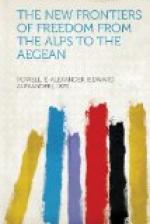The interior of Istria consists, in the main, of a barren, monotonous and peculiarly unlovely limestone plateau known as the Karst, a continuation of that waterless and treeless ridge, called by Italians the Carso, which stretches from Trieste northwestward to Goritzia and beyond. With the exception of the Bukovica of Dalmatia and the lava-beds of southern Utah, the Istrian Karst is the most utterly hopeless region, from the standpoint of agriculture, that I know. It is dotted with many small farmsteads, it is true, but one marvels at the courage and patience which their peasant owners displayed in their unequal struggle with Nature. The rocky surface is covered with a stunted, discouraged-looking vegetation which reminded me of that clothing the flanks of the mountains in the vicinity of the Roosevelt Dam, in Arizona, and here and there are vast rolling moors, uninhabited by man or animal, as desolate, mysterious and repelling as that depicted by Sir Arthur Conan Doyle in The Hound of the Baskervilles. The Karst, like the Carso, is dotted with curious depressions called dolinas, some of them as much as 100 feet in depth, the floors of which, varying in extent from a few square yards to several acres, are covered with soil which is as rich as the surface of the surrounding plateau is worthless. Because of the fertility of these singular depressions, and their immunity from the cold winds which in winter sweep the surface of the Karst, they are utilized by the peasants for growing fruits, vegetables and, in some cases, small patches of grain, being, in effect, sunken gardens provided by Nature as though to recompense the Istrians, in some measure, for their discouraging struggle for existence.




